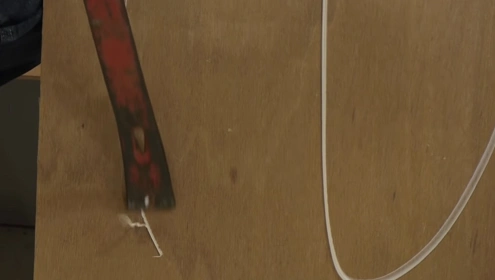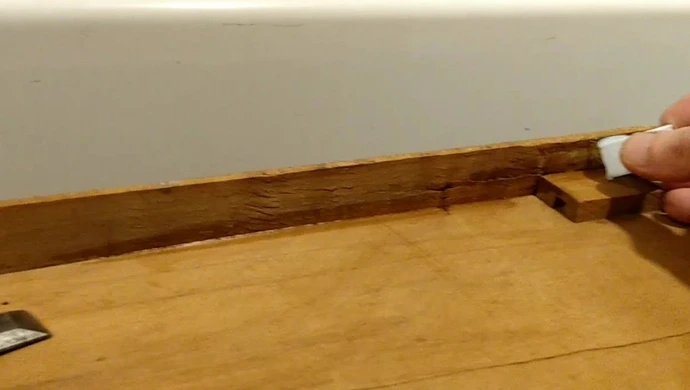Last Updated on December 5, 2022
Wood glue is an object that is used to join wood pieces. It can be used in both carpentry and furniture making and comes in either liquid or solid form.
Glue is applied to the surfaces of the wooden parts to be joined, and then clamped together until the glue sets. Do you have wood glue all over your walls?
Don’t worry; we’re here to help. Wood glue is a substance used to adhere pieces of wood together, but it can be difficult to remove if it’s not done properly. That’s why we’ve put together this guide on how to remove wood glue from wall.
Find out how to get rid of wood glue from your walls with our tips and tricks.
What are The Different Types of Wood Glue?
There are two types of wood glue: PVA and epoxy.
PVA (polyvinyl acetate) is the most common type of wood glue. It’s water-based, non-toxic, and easy to clean up with soap and water. PVA glue is best for small projects where the parts of wood will be close together.
Epoxy is a stronger, more permanent type of glue that is best for larger projects or projects where the pieces of wood will be far apart. Epoxy is more difficult to work with than PVA glue, and it is not water-soluble, so it’s essential to be careful when using it.
Methods on How to Get rid of Wood Glue from Walls

There are a few different methods you can use to remove wood glue from walls. The best method will depend on the type of glue you’re using and the size of the area you need to clean.
If you’re using PVA glue, the easiest way to remove it from your walls is with a soapy water and putty knife.
Putty Knife and Soapy Water:
1. Start by wetting a clean cloth with soapy water. It’s important to use mild soap so you don’t damage your walls.
2. Use the wet cloth to wipe away as much of the glue as possible.
3. After removing most of the glue, using a putty knife to scrape off any remaining glue.
4. Wipe the area with a clean, damp cloth to remove any soap residue.
5. Allow the area to dry completely before painting or to wallpaper over it.
If you’re using epoxy glue, the best way to remove it is with a putty knife and heat gun.
Heat Gun and Putty Knife:
1. Heating the area with a heat gun is the first step. The glue will become soft and pliable when it’s heated, making it easier to remove.
2. Use putty knife to scrape the softened glue away from the surface. Work slowly and carefully, so you don’t break the wall.
3. Using a damp cloth, wipe away any debris that may remain.
4. Repeat the process if necessary.
5. After the area has cooled completely, it is a good idea to paint or wallpaper over it.
Whatever method you choose, make sure to avoid damaging your walls. If you’re not sure how to remove wood paneling glue from drywall, test the method in a small, inconspicuous area first.
How to Remove Dried Wood Glue from Wall?

If you have dried wood glue on your wall, don’t worry. With a little bit of effort, you can remove it easily. Here are a few methods that you can use to get rid of the dried glue:
1. Scraping
The first step is to scrape off as much of the dry glue as possible. You can use a putty knife, razor blade, or even a credit card to do this. Just make sure that you don’t scratch the wall surface.
2. Soaking
Once you’ve scraped off most of the glue, you can soak a cloth in water and vinegar. Once the cloth has been soaked, apply it to the remaining glue and allow it to stand for a few minutes. This will help to soften the glue so that it’s easier to remove.
3. Rubbing
After the glue has been soaked, you can start rubbing it off with your cloth. You may need to use some elbow grease, but eventually, the glue should come off completely.
4. Washing
When you have removed all of the glue from the area, you can wash the area with soap and water to remove any residue that may remain.
You can easily removeing dried wood glue from your wall with a little effort. Just use one of the methods above, and you’ll have it clean in no time.
Preventing Wood Glue from Getting on Your Walls
The best way on how to remove wood glued to wall is to prevent it from getting there in the first place. Here are a few tips to help you prevent damage to your walls when using wood glue:
1. Use painter’s tape to create a barrier between the wall and the area where you’ll be working.
2. Cover your work surface with a drop cloth or old sheet to catch any drips or spills.
3. Apply glue to the wood, not the wall. This will help prevent accidental gluing of your walls.
4. Use clamps to hold the wood while the glue dries. This will help prevent any sliding or shifting that could cause the glue to get on your walls.
5. Clean up any spills or drips immediately. The longer the glue sets, the harder it will be to remove.
6. Allow the glue to dry completely before removing the clamps. In this way, you will prevent any accidental pulling or tearing of the glued area.
You can avoid damaging your walls with wood glue and stay stress-free while doing your next project by observing these tips.You can avoid damaging your walls with wood glue and stay stress-free while doing your next project by following these tips.
Tips for Cleaning Up Wood Glue
Whether you’re trying to removeing wood glue from your walls or clean up a spill, here are a some tips to make the process easier:
1. Act in a well-ventilated area. The fumes from some glues can be harmful, so it’s important to work in a well ventilated area.
2. Use warm water. It will help to break down the glue and make it easier to remove.
3. Make use of a soft cloth. A soft cloth will avoid scratching your walls or other surfaces.
4. Avoid using abrasive cleaners. It can damage surfaces and should be avoided when cleaning up wood glue.
5. Be patient. It may take a little time and effort to remove all of the glue, but it will be worth it in the end.
Final Thoughts
Wood glue is a handy tool to have around the house, but it can be tricky to use without damaging your walls. With these tips, you can avoid accidentally gluing your walls and have peace of mind while working on your next project. Thanks for reading.
You Can Also Check:
- What you can do to prevent future cat scratches on walls?
- What are the reasons for removing shelves from walls?
- Why should the wall heater be removed?

